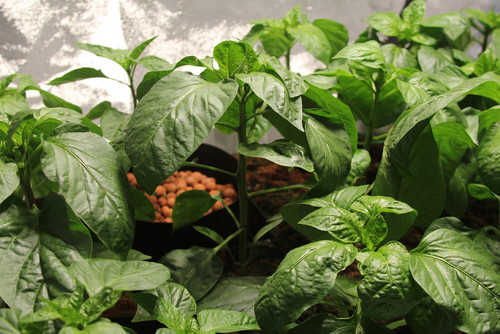What is Hydroponics?
Generally, hydroponics means growing plants without the use of a traditional soil (dirt medium), using only a nutrient rich water solution.
The mediums used are fiber glass, or sand, or clay ball or nothing at all. Several branches of hydroponics include aeroponics (using air as the medium), aquaponics etc.

Photo by GROWBIGOGH – Browse home design photos
Why Hydroponics?
Hydroponically grown foods not only taste better and are more nutritional, you can change the properties of your food, monitor what goes into your food and pollutes less.
You can also grow more in less space. This is especially great for those of us that do not have a backyard to grow in.
Hydroponic Systems
Choosing a hydroponic system will depend on several variables: what you’re growing, where you’re growing it, how much are you willing to spend as well what you plan to do with your crop (eat, sell, smoke and whatnot).
Beautiful Gardens | How To Build A House (howtobuildahouseblog.com)
Homemade Hydroponics
Homemade hydroponic systems not only offer this joy of DIY stuff, but they’ll also save you some serious pocket money. It is not too difficult to build your own homemade hydroponic system. Do it yourself hydroponics can be done indoors or outside in your backyard or garden.
What You Need to Build a DIY Hydroponic System?
For your DIY hydroponic system, all you need are some containers for your plants and reservoir, tubing to deliver the nutrients, a pump to flood your plants with the nutrient solution and a timer. The rest of the items you need are typical stuff that you will need for any other general hydroponic purposes.
However, one of the cheapest and easiest hydroponics systems employs gravity to transport the water to and from your growing container. It is a basic system, sometimes referred to as the bucket system or flooding system.
1] What you need is a clean plastic container, such as dishpan (3 to 4 inches tall) and a clean plastic bucket. You need also 3 to 4 feet plastic tubing with ½ to 1 inch diameter.
2] Make a hole in one of the plastic container short side. This hole should be the same diameter as the plastic tubing and ½ to 1 inch above the bottom of the container.
3] Cut a hole in the side of the bucket the same size as the diameter of the tubing. Make this hole 1 to 2 inches from the bottom of the bucket.
4] The next step is to insert one end of the tubing into the hole in the bucket and the other end of the tubing into the hole in the plastic container. Seal both ends with silicone or aquarium cement.
5] You need to position the plastic container below the level of the bucket. So, place the plastic container on a tabletop. Fill with perlite or comparable growing medium. Place the bucket on a higher surface, such as a taller table next to the table with the plastic container.
6] Plant small seedlings in the growing medium. Slowly add water that has been enriched with appropriate nutrients to the plastic container until the growing medium is completely moistened.
7] Than, you should lower the bucket to the floor and allow the water to drain from the plastic container. This allows you to determine how much water is needed to process through the system. This will help you avoid flooding the container with too much water and dislodging your seedlings.
8] Allow 2, 3 hours for water to be completely drained. Than raise the bucket in the old position, above the plastic container level. The water will drain down into the plastic container from the bucket. When the water has completely drained from the bucket, lower the bucket and allow the water to drain back into the bucket.
9] You should do that two to three times a day. Add an additional cup or two of nutrient rich water to the bucket system once a week or as needed to maintain the amount needed to process through the system. Renew the water completely once a month.
What are the Benefits of Hydroponics?
Using hydroponics, you will realize that it is much easier to maintain your plants and containers as there is minimized risk of you facing any weed or pest problem. That will reduce the need to apply pesticide to your plants.